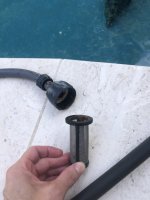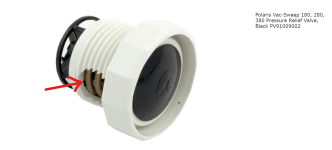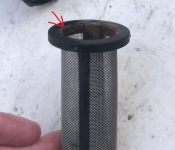- Jul 13, 2023
- 7
- Pool Size
- 16000
- Surface
- Plaster
- Chlorine
- Salt Water Generator
- SWG Type
- Pentair Intellichlor IC-40
Greetings from Houston!
Hoping for help with a “minor rust” question. Specifically - reoccurring on the metal screen of the In-line filter for Polaris 280 Max Black cleaner.
I appreciated the education I received from TFP years ago, when we bought this house with a pretty pool 10+ years ago. After firing a multitude of pool guys and gals and ditching the pucks, I became a liquid chlorine girl and while physical maintenance was rugged due to an oak overhead and a host of pigeons living within it... (enough said!), I managed to stop the cycle of green bouncing and had clear water with the help of TFP and my big kit.
We demo’d the house and built new (took FOUR years - adding grey hairs and stories to tell). And because everything in the pool was OLD and wrong sized, and we had to empty and punch weep holes in bottom anyway, we renovated the pool afterwards.
I am NOT a fan of the WetEdge surface we used. Still cannot discern if we had a bad install or if is just the nature of the product.
Meanwhile: We installed a new DE filter (previously had a massive sand), a new Polaris 280, dropped our heater and filled in the spa to be a shallow sun perch. I originally was using chlorine - but after much research decided to install a SWG.
Bags of salt are SO much easier to deal with (and less often needing to be hauled) than my boxes of liquid chlorine from the pool store!!!!
Aside from a black algae issue last summer (because we let the boys use the neighbors’ gifted to us from their lakehouse yellow kayak in our pool - a joyful, if less than pool-smart decision) and signs of its return now, which I have tackled myself, we have had no issues.
Except for mysterious rust colored stains on my poolbaskets, pump basket, and pool walls near jets.
2 months ago - I discovered that the in-line filter screen for the Polaris was rusting. I popped it out, replaced it. Today I see that it is rusting again.
I bought the replacement filters from Leslie’s and they are in Polaris marked bags, so appear to be genuine.
Do any of you have recommendations or ideas for combatting this? I am trying to track down a brand new inline filter housing, to replace the whole thing. We are not vain, I do not care about the current rust staining, it will fade am sure - I do want to stop the rust cycle and not be damaging anything in the system.
If this message is not too wordy and my photo file is not too large, will attempt to upload a snapshot.
Thank You!
Hoping for help with a “minor rust” question. Specifically - reoccurring on the metal screen of the In-line filter for Polaris 280 Max Black cleaner.
I appreciated the education I received from TFP years ago, when we bought this house with a pretty pool 10+ years ago. After firing a multitude of pool guys and gals and ditching the pucks, I became a liquid chlorine girl and while physical maintenance was rugged due to an oak overhead and a host of pigeons living within it... (enough said!), I managed to stop the cycle of green bouncing and had clear water with the help of TFP and my big kit.
We demo’d the house and built new (took FOUR years - adding grey hairs and stories to tell). And because everything in the pool was OLD and wrong sized, and we had to empty and punch weep holes in bottom anyway, we renovated the pool afterwards.
I am NOT a fan of the WetEdge surface we used. Still cannot discern if we had a bad install or if is just the nature of the product.
Meanwhile: We installed a new DE filter (previously had a massive sand), a new Polaris 280, dropped our heater and filled in the spa to be a shallow sun perch. I originally was using chlorine - but after much research decided to install a SWG.
Bags of salt are SO much easier to deal with (and less often needing to be hauled) than my boxes of liquid chlorine from the pool store!!!!
Aside from a black algae issue last summer (because we let the boys use the neighbors’ gifted to us from their lakehouse yellow kayak in our pool - a joyful, if less than pool-smart decision) and signs of its return now, which I have tackled myself, we have had no issues.
Except for mysterious rust colored stains on my poolbaskets, pump basket, and pool walls near jets.
2 months ago - I discovered that the in-line filter screen for the Polaris was rusting. I popped it out, replaced it. Today I see that it is rusting again.
I bought the replacement filters from Leslie’s and they are in Polaris marked bags, so appear to be genuine.
Do any of you have recommendations or ideas for combatting this? I am trying to track down a brand new inline filter housing, to replace the whole thing. We are not vain, I do not care about the current rust staining, it will fade am sure - I do want to stop the rust cycle and not be damaging anything in the system.
If this message is not too wordy and my photo file is not too large, will attempt to upload a snapshot.
Thank You!







